Abstract
The concentrations of IgG subclass antibodies (Ab) to acetylcholine receptor (AchR) were quantified in 36 patients with myasthenia gravis (MG) treated with pyridostigmine only, and in eight patients who underwent thymectomy, using an IgG subclass-specific immunoprecipitation assay. IgG1, IgG2, IgG3, and IgG4 subclass Ab to AchR were present in 100%, 33%, 64% and 39% of the pyridostigmine-treated patients, respectively. The concentration of IgG1 Ab increased significantly with disease severity as graded by the Osserman-Genkins classification (rs = 0.37, P less than 0.05). IgG1 and IgG3 subclass protein concentrations were significantly higher (P less than 0.0003) in the 36 pyridostigmine-treated MG patients than in 44 age- and sex-matched healthy subjects. Thymectomy induced an appreciable reduction in anti-AchR IgG1 concentration in two patients, whereas six patients showed no changes in Ab to AchR. The results support the hypothesis that binding of anti-AchR IgG1 and IgG3 on AchR in the neuromuscular junction followed by complement-mediated cell lysis or phagocytosis, may play a role in the pathogenesis of MG.
Full text
PDF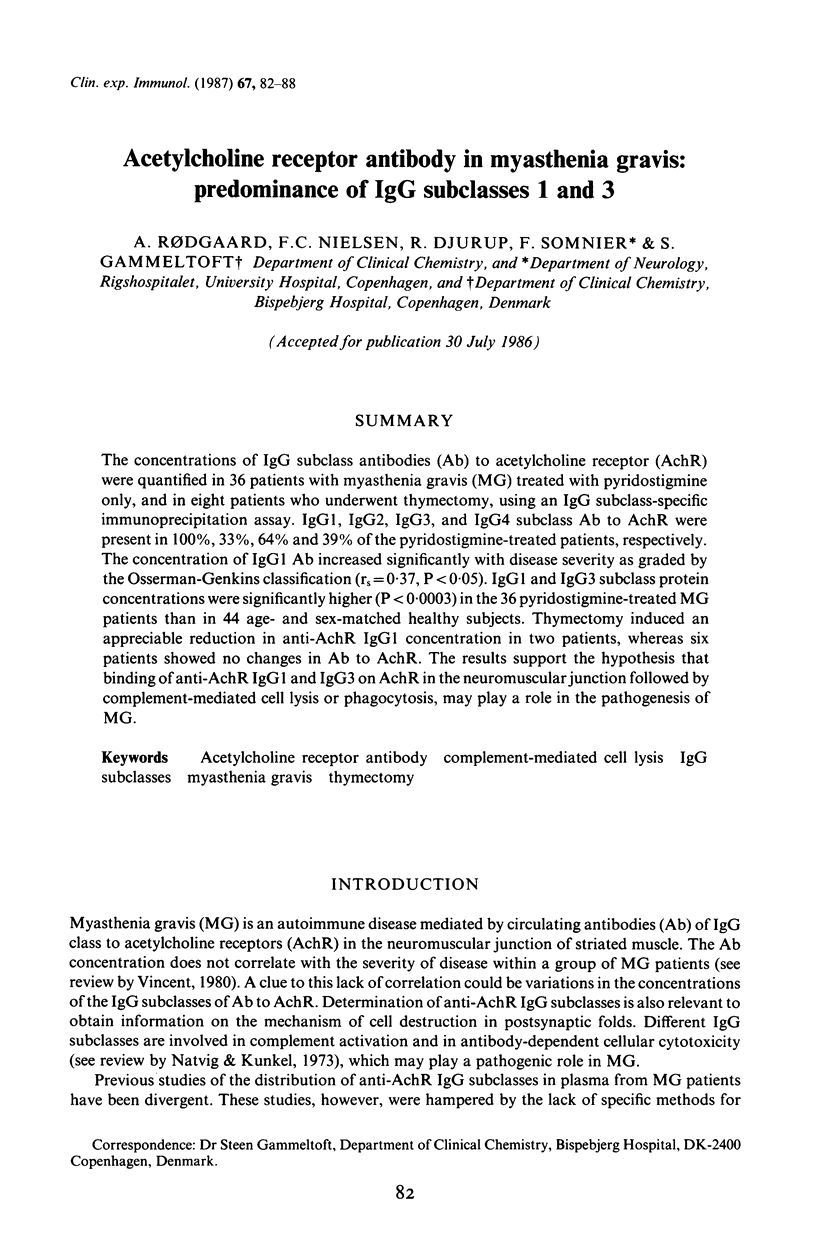
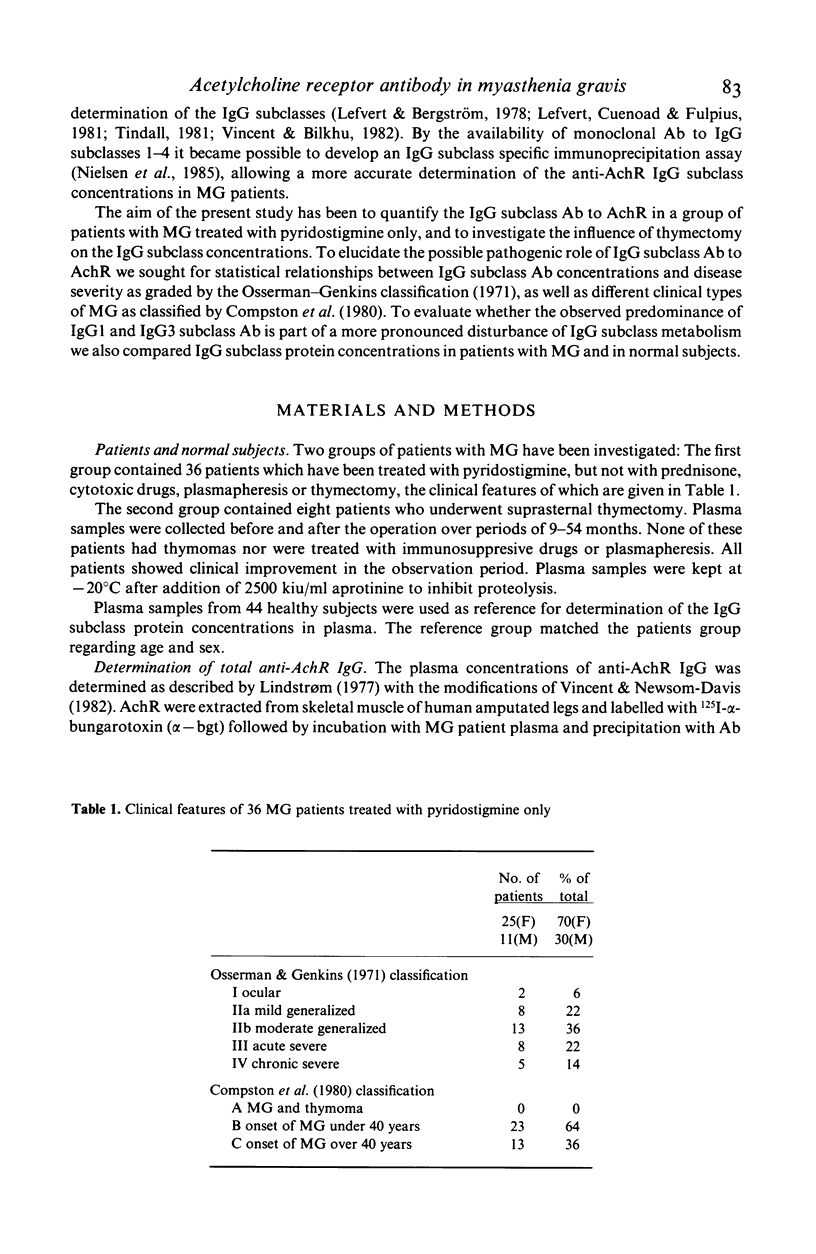

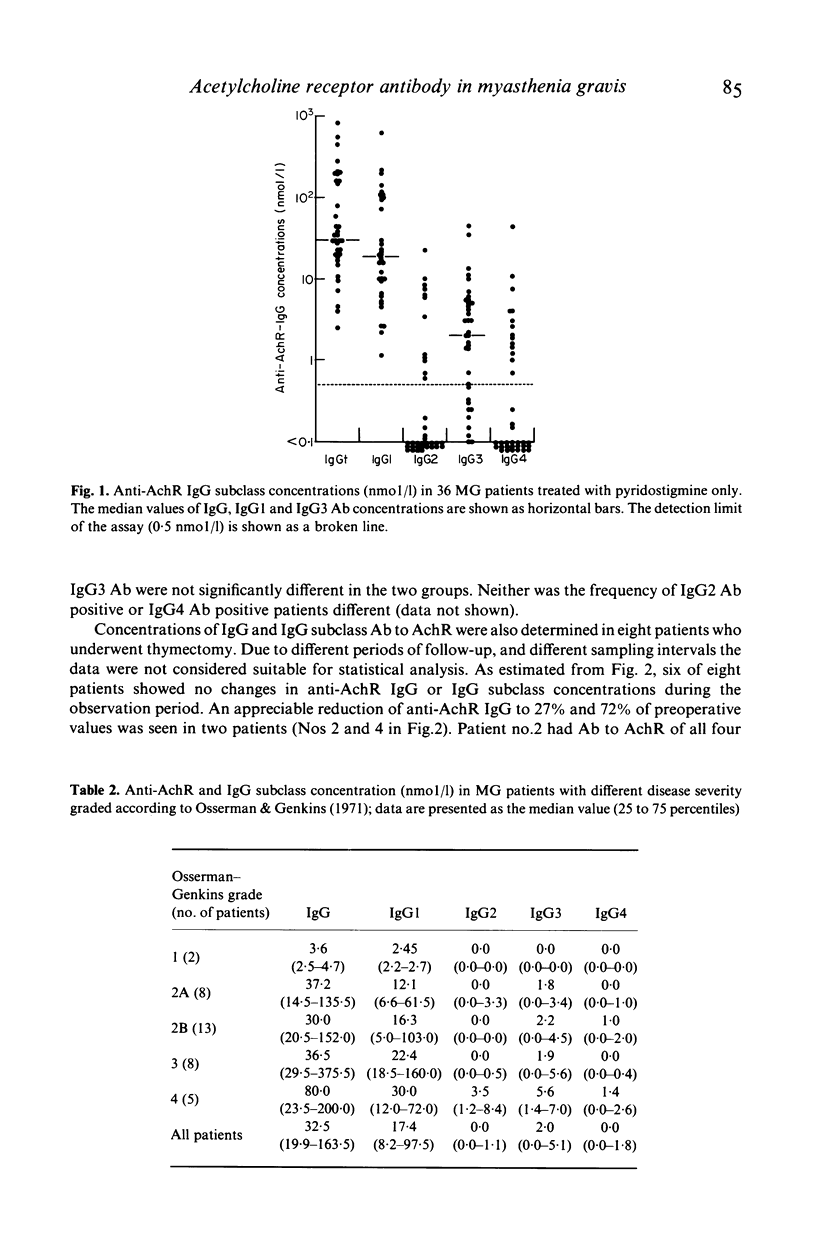
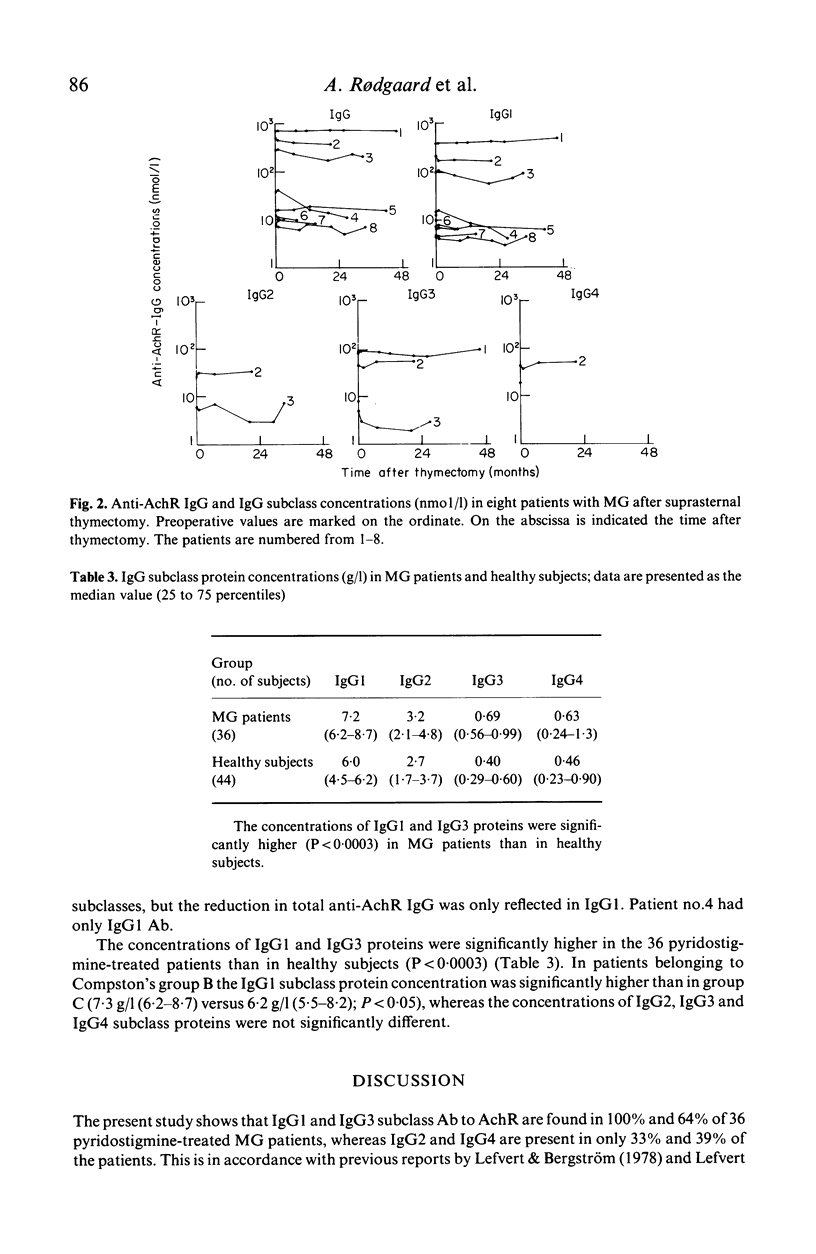
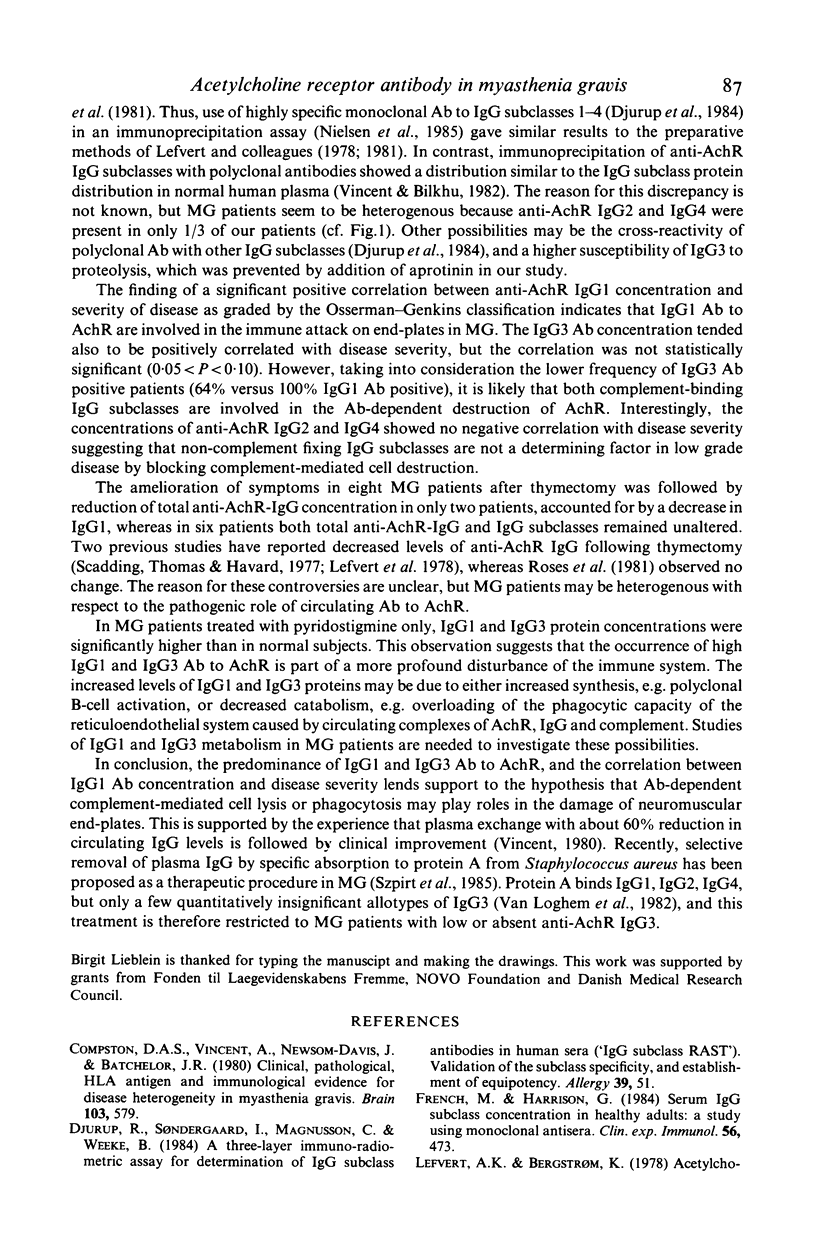
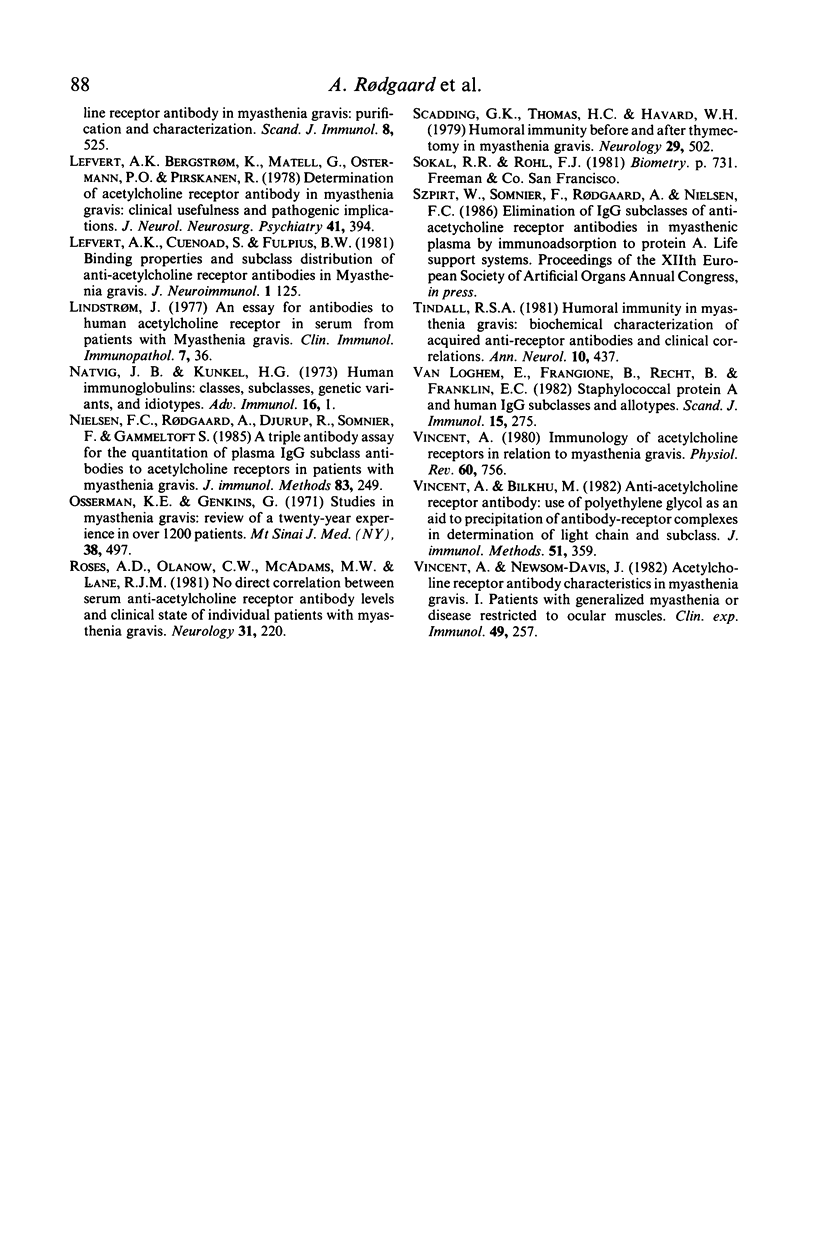
Selected References
These references are in PubMed. This may not be the complete list of references from this article.
- Compston D. A., Vincent A., Newsom-Davis J., Batchelor J. R. Clinical, pathological, HLA antigen and immunological evidence for disease heterogeneity in myasthenia gravis. Brain. 1980 Sep;103(3):579–601. doi: 10.1093/brain/103.3.579. [DOI] [PubMed] [Google Scholar]
- Djurup R., Søndergaard I., Magnusson C. G., Weeke B. A three-layer immunoradiometric assay for determination of IgG subclass antibodies in human sera ("IgG subclass RAST"). Validation of the subclass specificity, and establishment of equipotency. Allergy. 1984 Jan;39(1):51–63. doi: 10.1111/j.1398-9995.1984.tb01933.x. [DOI] [PubMed] [Google Scholar]
- French M. A., Harrison G. Serum IgG subclass concentrations in healthy adults: a study using monoclonal antisera. Clin Exp Immunol. 1984 May;56(2):473–475. [PMC free article] [PubMed] [Google Scholar]
- Lefvert A. K., Bergström K. Acetylcholine receptor antibody in myasthenia gravis: purification and characterization. Scand J Immunol. 1978;8(6):525–533. doi: 10.1111/j.1365-3083.1978.tb00552.x. [DOI] [PubMed] [Google Scholar]
- Lefvert A. K., Bergström K., Matell G., Osterman P. O., Pirskanen R. Determination of acetylcholine receptor antibody in myasthenia gravis: clinical usefulness and pathogenetic implications. J Neurol Neurosurg Psychiatry. 1978 May;41(5):394–403. doi: 10.1136/jnnp.41.5.394. [DOI] [PMC free article] [PubMed] [Google Scholar]
- Lefvert A. K., Cuénoud S., Fulpius B. W. Binding properties and subclass distribution of anti-acetylcholine receptor antibodies in myasthenia gravis. J Neuroimmunol. 1981 Mar;1(1):125–135. doi: 10.1016/0165-5728(81)90015-1. [DOI] [PubMed] [Google Scholar]
- Lindstrom J. An assay for antibodies to human acetylcholine receptor in serum from patients with myasthenia gravis. Clin Immunol Immunopathol. 1977 Jan;7(1):36–43. doi: 10.1016/0090-1229(77)90027-7. [DOI] [PubMed] [Google Scholar]
- Natvig J. B., Kunkel H. G. Human immunoglobulins: classes, subclasses, genetic variants, and idiotypes. Adv Immunol. 1973;16:1–59. doi: 10.1016/s0065-2776(08)60295-3. [DOI] [PubMed] [Google Scholar]
- Nielsen F. C., Rødgaard A., Djurup R., Somnier F., Gammeltoft S. A triple antibody assay for the quantitation of plasma IgG subclass antibodies to acetylcholine receptors in patients with myasthenia gravis. J Immunol Methods. 1985 Nov 7;83(2):249–258. doi: 10.1016/0022-1759(85)90247-9. [DOI] [PubMed] [Google Scholar]
- Osserman K. E., Genkins G. Studies in myasthenia gravis: review of a twenty-year experience in over 1200 patients. Mt Sinai J Med. 1971 Nov-Dec;38(6):497–537. [PubMed] [Google Scholar]
- Roses A. D., Olanow C. W., McAdams M. W., Lane R. J. No direct correlation between serum antiacetylcholine receptor antibody levels and clinical state of individual patients with myasthenia gravis. Neurology. 1981 Feb;31(2):220–224. doi: 10.1212/wnl.31.2.220. [DOI] [PubMed] [Google Scholar]
- Scadding G. K., Webster A. D., Ross M., Thomas H. C., Havard C. W. Humoral immunity before and after thymectomy in myasthenia gravis. Neurology. 1979 Apr;29(4):502–506. doi: 10.1212/wnl.29.4.502. [DOI] [PubMed] [Google Scholar]
- Tindall R. S. Humoral immunity in myasthenia gravis: biochemical characterization of acquired antireceptor antibodies and clinical correlations. Ann Neurol. 1981 Nov;10(5):437–447. doi: 10.1002/ana.410100506. [DOI] [PubMed] [Google Scholar]
- Van Loghem E., Frangione B., Recht B., Franklin E. C. Staphylococcal protein A and human IgG subclasses and allotypes. Scand J Immunol. 1982 Mar;15(3):275–278. doi: 10.1111/j.1365-3083.1982.tb00649.x. [DOI] [PubMed] [Google Scholar]
- Vincent A., Bilkhu M. Anti-acetylcholine receptor antibody: use of polyethylene glycol as an aid to precipitation of antibody-receptor complexes in determination of light chain and subclass. J Immunol Methods. 1982;51(3):359–369. doi: 10.1016/0022-1759(82)90404-5. [DOI] [PubMed] [Google Scholar]
- Vincent A. Immunology of acetylcholine receptors in relation to myasthenia gravis. Physiol Rev. 1980 Jul;60(3):756–824. doi: 10.1152/physrev.1980.60.3.756. [DOI] [PubMed] [Google Scholar]
- Vincent A., Newsom-Davis J. Acetylcholine receptor antibody characteristics in myasthenia gravis. I. Patients with generalized myasthenia or disease restricted to ocular muscles. Clin Exp Immunol. 1982 Aug;49(2):257–265. [PMC free article] [PubMed] [Google Scholar]


